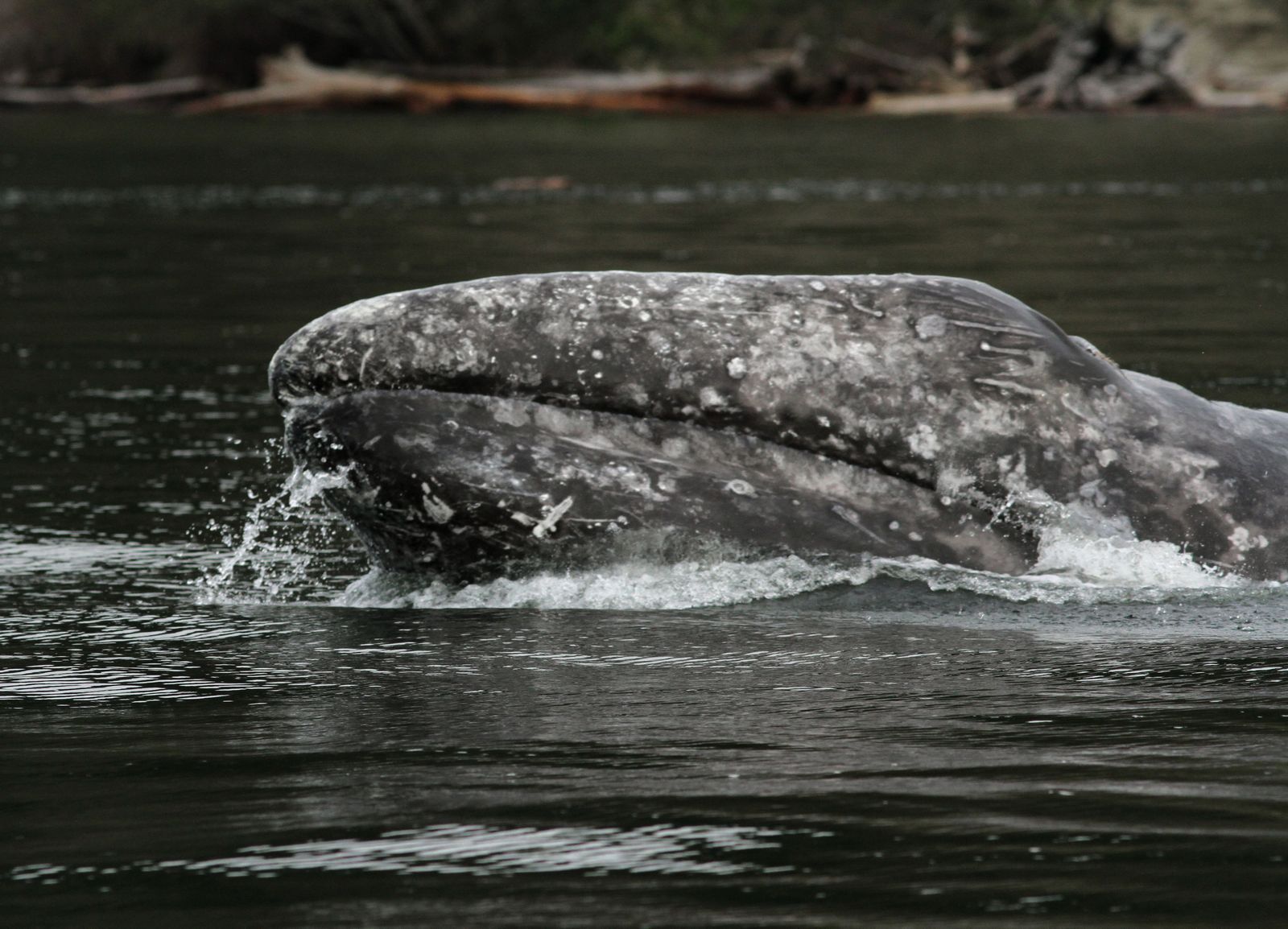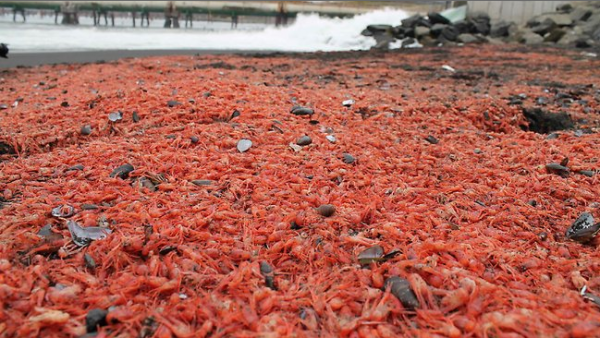A few whales found good feeding grounds in the ’80s and they apparently spread the word.
Mike Benbow, The Herald

A gray whale surfaces in the Port Gardner bay area near Mission Beach recently. Gray whales migrate between Mexico and Alaska every year. From March through May, they’re headed north. About a dozen whales venture into Possession Sound, Port Gardner and Port Susan to stop and feed.
Residents of the Puget Sound area have their own special group of gray whales, and they have the lowly ghost shrimp to thank for it.
Ghost shrimp, also called sand shrimp, live in the sandy flats of bays along the Pacific Coast from Baja to Alaska. That, coincidentally, is the range for migrating gray whales, who have their young in the warmer, saltier waters of Baja, Mexico, and then swim some 5,000 to 6,000 miles to feed in the rich waters of the Arctic.
The migration of some 22,000 whales is under way and a number of them have been reported in the Sound and in the straits of Washington and British Columbia, according to the Pacific Whale Watch Association.
For a growing number of the whales, the Sound is a reliable pit stop where they can refuel while en route from Baja to the Bering and Chukchi seas.
In Baja, the whales fast for three to five months while giving birth to their young, and that’s where the Sound comes in.
Sometime in the late 1980s a whale or two started coming into Puget Sound regularly and found plenty of sand shrimp around the bays along Whidbey and Camano islands and along Mission Beach and Kayak Point in Snohomish County.
“They couldn’t make it through their (blubber) reserve, and they came into Puget Sound searching for food,” said John Calambokidis, a co-founder of Cascadia Research in Olympia, who has been studying gray whales in Washington state since 1990.
He said the local trip may have been promoted by a poor feeding season in Alaska, followed by a fasting period in Mexico that left them emaciated. “They needed to feed on something to help them pull the motor,” Calambokidis said.
His nonprofit group mostly does research for state and federal agencies. Whales are a big part of its work, and one thing Cascadia does is provide photo identification of specific whales.
Calambokidis said there isn’t a huge amount known about gray whales. For example, scientists don’t know old they get.
“The aging techniques aren’t very good at measuring maximum age,” he said.
The whales had been expected to live “30 to 40 to 60 years,” he said. But he noted that some bowhead whales were recently found with ancient harpoon points inside them that haven’t been used for more than 100 years.
So grays could last a lot longer than people thought.
That’s important because the feeding whales in the Sound are apparently teaching others, certainly their young, to stop here for a snack on their way north.
Calambokidis said that from one or two grays, the group feeding around Whidbey has expanded to six whales that come every year in February and March and leave in May or June. The first of this year’s group was spotted in February off Mission Beach on the Tulalip Indian Reservation.
“Eleven or 12 different individuals” were sighted in the Sound (last year),” Calambokidis said. “Of those, 10 animals we know and one or two were new.”
The Puget Sound whales are a little different from other grays that migrate along the Pacific Coast each year, Calambokidis said. He said what’s called the Pacific Coast feeding group moves up from Washington’s coast to Vancouver Island to feed.
But not the Puget Sound whales. “When they leave, (the Sound) you don’t encounter them,” he said. “They move out of the area. I suspect they move up to traditional feeding areas in Alaska.”
While some whales have been found stranded and have died in Washington, grays in general have made a remarkable comeback. He noted that before whaling days, there were an estimated 15,000 gray whales.
During whaling, they were hunted to near extinction. “Now this population has completely recovered and exceeds the numbers prior to whaling,” Calambokidis said.
He noted that the Puget Sound whales seem to have a high survival rate. “Feeding a month or so before migration has kept them in good health for the last 20 years,” he said.
A gray whale found dead off Whidbey last year was not part of the group identified as a regular feeder in the Sound, he said.
Whales feeding on ghost shrimp during higher tides come surprisingly close to shore. The whales, which grow to 40 or 50 feet in length and can weigh 60,000 to 80,000 pounds, sometimes swim along Mission Beach about a body’s length away from the beachfront homes.
Parts of their tails and fins come out of the water as they roll in the sand, using their snouts to stir up a slurry of sand, water and ghost shrimp. They eject the water and sand through baleen filter plates in their upper jaw, swallowing the shrimp.
The whales leave behind holes in the sand that at low tide make the beach look like a golf course filled with divots.
But homeowners don’t mind.
The whales are welcome visitors, and word spreads quickly each year when they’re first sighted.
Jerry Solie, whose family has had a home on Mission Beach since 1937, first noticed the whales in 1989.
“They kept us awake all night,” he said, referring to feeding whales spouting water in the air below his bedroom window.
Solie said he looks forward to the annual visit.
“They come so close, and they’re so big,” he said. “It makes it hard to get any work done because if they’re there, you have to watch them.”
He said the giant mammals are unusually friendly to the point where you wonder who’s watching who.
“Twice I’ve had them come up right along my boat and look at me,” he said. “They’re watching me too.
Whale tours
Island Adventures, Everett: www.island-adventures.com/. Call 800-465-4604.
Deception Pass Tours, Oak Harbor: www.deceptionpasstours.com/. Call 888-909-8687.
Mystic Sea Charters, Langley: www.mysticseacharters.com/. Call 800-308-9387.
WSU Island County Beach Watchers: Fund-raising tour departs at 4 p.m. April 6 from Langley Marina. Call 360-331-1030 or signup online at beachwatchers.net/events/whales. The three-hour cruise includes appetizers, beverages and onboard naturalists for $75 a person.















 City of Marysville Parks and Recreation
6915 Armar Rd.
Marysville, Washington 98270
(360) 363-8400 * web: marysvillewa.gov
City of Marysville Parks and Recreation
6915 Armar Rd.
Marysville, Washington 98270
(360) 363-8400 * web: marysvillewa.gov
